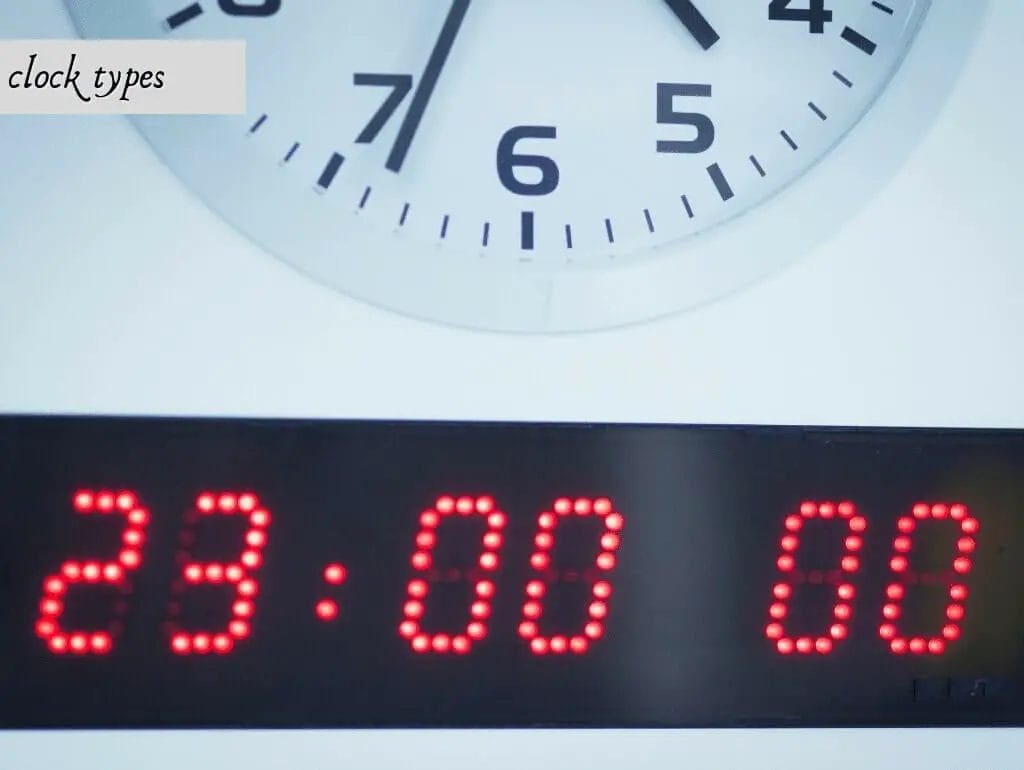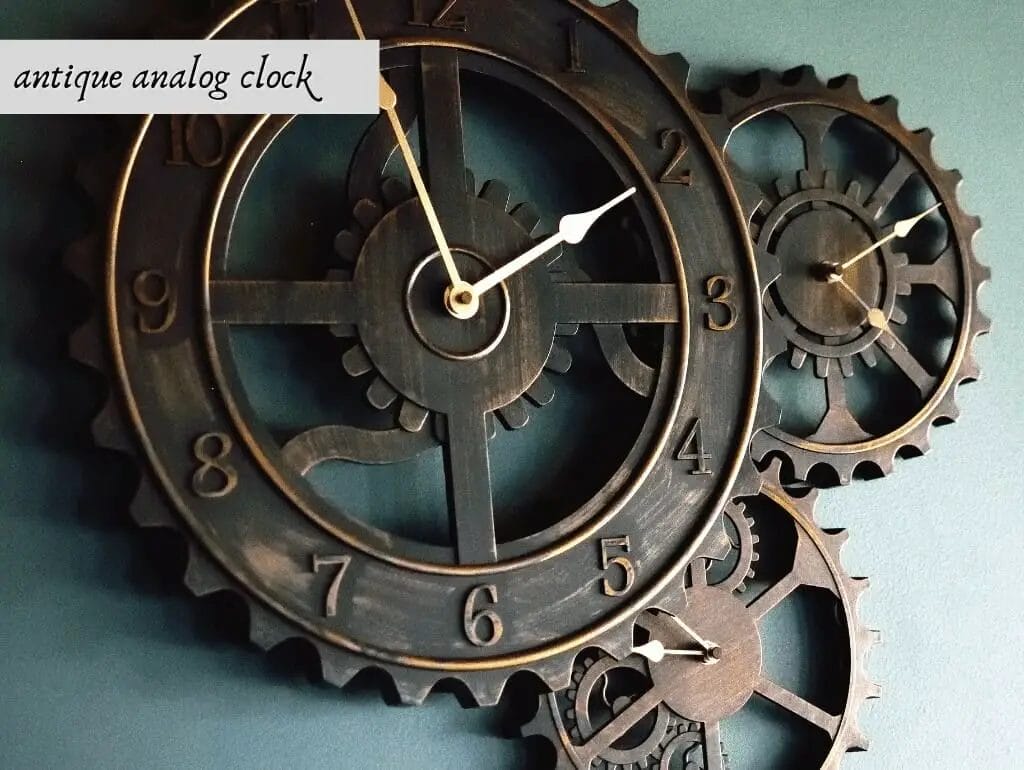In the past, you could know a room with a clock by hearing the ticking sound. Most conventional clocks produced a loud tick sound. Due to innovation and improved technology, you will find quiet or less sound-producing clocks on the market today.

Some people still use analog clocks because of their unique designs and longevity. Others love the sounds they make, as it connects them to the past. According to them, the entire ticking clock comes as an aesthetic package that helps them track their time.
But it’s not the same case with most people. The ticking sound in clocks can be a nuisance. You may find it difficult to enjoy your sleep or concentrate with the clock producing the ticking sound. Whether you are a fan of the clocks that tick or not, you may wonder why they produce such a sound. You also could be interested in knowing how such clocks got invented.
You shall get the answers in this article. You will also learn how you can make a ticking clock silent or stop producing the loud noise. You may need to continue reading to learn more about ticking clocks. Let’s start by understanding how they got invented.
The Evolution of the Ticking Clocks
The ticking clocks were born when the mechanical clocks got invented. The first clocks that used a pendulum to calculate time became famous because of their ‘tick-tock’ sounds. It means that these kinds of clocks produced two types of sounds after each second.
The sounds were a result of the pendulum moving right and left. When the pendulum swung to the left, it produced a certain sound. When it went to the right side, a different sound got produced, hence the ‘tick-tock’ sound.
Today, you can hardly see a clock using the pendulum. Most clocks use batteries, making them produce only one sound, thus the ‘ticking’ sound.
Now that you are aware of how the ticking clocks came about, let’s look into why they make a ticking sound.
The Reason Clocks Make a Ticking Sound
Clocks get made with the second, minute, and hour hands. The second hand rotates and stops at every second. The movement produces a small vibration that makes the ‘tick’ sound. Every second the second-hand moves, you get to hear the sound.
It also applies to quartz clocks. For every moment, a ticking sound gets produced. Quartz clocks are popularly used in our homes. They operate using batteries. However, the mechanical clocks are different. They produce two different sounds referred to as the ‘tick and tock’ sound. Fortunately, they are not common today.
Unlike the clocks that produce a single sound, mechanical clocks come with gears that rotate forward and backward. Above the gears is a double-sided fork that allows the gears to move forward a bit more every time. When the double fork strike on the gears’ right side, a sharp sound, also known as the ‘tick’ sounds, gets produced. When the fork hits the gears’ left side, a higher based sound gets emitted, also referred to as the ‘tock’ sounds.
You may be for tradition, but the analog clocks in your home are not giving you peace of mind. You could be wondering how you can make the noise stop, and properly that’s why you landed on this article. No need to worry; this guide is for you. The following are ways you can quiet your clocks forever.
Can You Make a Ticking Clock Silent?
The answer is yes. There exist various ways of doing so. You can reduce the clock’s ticking sound by;
- Oiling the clock’s mechanism
- Place the clock inside a container
- Adjust the clock
- Add weight to the clock’s mechanism
- Get a mains-powered clock
- Buy a silent clock
Let’s expound on each of the above ticking sounds removing methods.
i. Oiling the Clock’s Mechanism
Oiling the clock’s moving parts enables them to run smoother. But oiling with heavier oil will add tension to the mechanisms. If you are to use this method, you need to understand how the clock’s mechanisms work. Otherwise, you may end up spoiling your clock.
The clock’s mechanisms are sensitive and complicated. It would be best if you were sure of yourself when taking the clock apart for oiling. You also need to know your type of clock. Can you access its mechanisms? Most cheap clocks on the market are hard to reach to their ticking mechanism.
Start by removing the clock’s cover. If secured using screws, unscrew them. If you can access the parts, well and good, you can oil that clock. What differentiates clocks are the materials used in their making and size. Otherwise, they all follow the same formula.
If your main reason for oiling the clock’s parts is to lubricate them, use the oil specially made for clocks. But you can use oil to add weight to the clock’s mechanisms. Regarding this, you need to use heavier oil. It will make the gears quiet due to the increased tension.
Great examples of heavier oils to use are 5W OR 20W vehicle oils. Use the following procedure to oil the mechanisms;
Step 1
Remove the back cover of the clock to reach the mechanisms. Identifying them is easy as they get connected to the clock hands. It’s easy to remove the back plate.
Step 2
Remove all knobs found in the back panel. Not all clocks have them. It depends on the quality of your clock. Remember to note where you remove each knob or part. It will make it easier when reassembling the parts. Removing the knobs is like a downhill task.
Step 3
Open the housing of the clock’s mechanism. It would help if you were very gentle and careful with this because the gears may fall out when you force them. If they fall out, your clock is as good as dead.
Step 4
Locate the gear that gets moved by a small coil. It is the one responsible for moving the second hand, which causes the ticking sound. Take a drop of oil and place it on this gear. Use a toothpick’s end to drop the heavy oil; it works out great.
Step 5
After oiling the gear rotated by a tiny coil, also oil the gear that connects to it. Please start with the bearings and then apply the oil to its teeth. You should oil only these two gears.
Step 6
If you opt to use the clock oil, spray only a small amount on the entire mechanism. Ensure it coats all gears. Whether you use the heavy or clock oil, allow the clock to remain open for approximately 30 minutes. In return, any excess oil will evaporate.
Step 7
After the time has expired, it’s time to reassemble your clock. Put each part where you removed it. Ensure the parts sit in their positions correctly. If not, the clock may not work.
ii. Place the Clock Inside a Closed Container
If your clock is large, this option may not work. It isn’t easy to find large containers to place a clock. Use this method with a small bedside alarm or desk clocks. What you’ll love with this technique is its accuracy. You only need to airtight the container. The ticking sound will not leak out.
This method’s only setback is making people understand why you have placed your small clock in a mason or pickling jar. If you can’t get a container to use, try a glass cloche. But it will only sit on the clock’s surface. It means the clock won’t get sealed airtightly, making the noise leak. But the sound will get reduced.
Placing an alarm clock in a well-sealed container makes the alarm useless because you won’t hear it when it signals. Any noise gets sealed. You may need to consider this when using this method. Some clocks vibrate or shake when alarming you.
If yours is this type, you will need to open the jar and switch off the alarm. You may not hear the alarm, but you will see the clock shaking or vibrating. It is not something you will want to keep on doing!
iii. Adjust The Clock
Unfortunately, you cannot modify any clock. Large clocks are hard to adjust their parts. But it’s a piece of cake with small alarm clocks. Depending on your clock type, you can adjust its parts to reduce or fully eliminate the noise. You can use the following methods;
- Shorten the Second Hand: Modern clocks get made with cheapmaterials like plastic. Such materials are easy to modify. The loud noise from clocks comes from the strong force emitted by the stepper motor at various points. In some points, the force is slacker than others due to the clock’s construction. As a result, the clock gets able to tick from an hour or minute to the next.
The only effective way of removing or reducing the loud noise is by shortening the second hand. You can use a pair of scissors to cut it. When it’s short, the flex is less, making it hard for the vibrations to travel. Though you cut the second hand based on the clock’s size, leaving a quarter of it on any clock will work out fine.
- Use Something that Dampens the Clock’s Ticking Sound to Wrap it: You can use a towel or piece of cloth, but this is when you don’t have to read the time. The better option of this method is to go for transparent soundproof materials. You will be able to read the time and keep the noise away.
While using this method, remember it may appear a bit fiddly wrapping your clock.
iv. Add Weight to the Clock’s Mechanism
Unlike the analog clocks fitted with complicated moving parts, the modern clocks come with a simple motor to help turn the hands. Adding mass on the clock to reduce or eliminate noise works excellently on wall clocks.
Their mechanism comes inside a unit for the alarm or bedside clocks, making it hard to add some mass. But it still works on such clocks, though not very effective. It is better to try on the smaller clocks. All you need to do is to remove your clock from the wall and check its back. At the center, you’ll find a tiny plastic box, the place where you place your batteries.
Take some mass of soundproofing material and place it on the mechanism. You can use things like a thick quilt. Then take some tape and secure the mass on the mechanism.
The noise blocked using this technique is the one coming from the back. It means that you will still hear sounds from the front side. It is, therefore, not a very effective mechanism to use. You will also have to peel off the mass every time you want to place new batteries.
v. Get a Mains-powered Clock
Most clocks get powered by a battery, except for the expensive ones like the alarm clock radio. It means that the majority of clocks make the ticking clock. If you have tried the above methods and don’t get the expected results, try switching to using a main-powered clock. It synchronizes its time through the mains frequency.
That’s why you will find such clocks with no second hands. Those that have consist of the rotating kind, and not the ticking kind. They, therefore, make no noise. Other mains-powered clocks use radio frequencies to synchronize time. The advance in technology has resulted in others getting powered by batteries. Whatever mechanism they use, the mains-powered clocks don’t make any sound.
vi. Buy a Silent Clock
You could have tried the above techniques, and nothing worked as you wanted. The best solution is to purchase a silent clock. Fortunately, the market is flooded with so many of them. You only need to choose the size and design you want. It also depends on your budget.
Great examples are the digital clocks. They hardly make any sound.
If you don’t love digital clocks, try buying a quality clock of any kind. If it makes the ticking sounds, it will be easy to use the above methods to eliminate or reduce the noise.
You may own a ticking clock and also know about reducing or eliminating its sound. But do you have an idea how it operates? Here is the insight. Let’s start by looking into the clock’s inside.
What to Find Inside Your Ticking Clock
I. A Source of Energy
It is what provides energy to the clock hands to move. It could either be an electric appliance, battery, springs, solar power, or any other source.
II. A Mechanism for Keeping Time
It is a method used by the clock to calculate the passing time accurately.
III. Display
It is the visible part and comes in various styles. In all clocks, it is the face or the front part. The display could come in an animation design or your favorite shape.
It depends on its maker. The front side of the face could come covered with glass or any other transparent material.
With the above components of a clock, we can define a clock as a device that uses the energy supplied to offer period variations. Regarding this, here is how ticking clocks work.
How a Ticking Clock Operates
Step 1
The power source, such as the battery, gives energy to the clock’s microchip circuit. The circuit gets located within the clock.
Step 2
When the microchip receives the energy, it produces some current that makes the quartz crystals vibrate. The crystals come precisely cut within the clock. Each second, the crystals vibrate 32768 times.
Step 3
The microchip circuit then detects the vibration from the quartz crystals. The circuit transforms these vibrations into standard electric pulses, usually 1 – speed for every 1 – second. It is what is required for normal and accurate clock functioning.
Step 4
The electric pulses then transform into mechanical power and make the clock’s gears move. When one gear moves, it makes the other one move. In return, the clock keeps on ticking every second as long as the energy source stays intact.
With all the above information provided above, you got everything you need to know about ticking clocks. But some questions could still linger in your mind. No need to worry. Here are some of the questions that bother most people. We shall give their answers to help you understand or clear anything you are struggling with about the ticking clocks.
FAQs
1. Can You Stop a Clock From Ticking Loudly
As explained above, there are various ways you can make your clock not tick loudly. Some techniques like adding weight to the clock’s mechanism and adjusting it may not entirely remove the sound. But they are excellent methods in reducing a loud ticking sound.
If you want to eliminate the noise, you could place it in a container or oil the mechanism. Shortening the second hand will also work like magic.
2. What Makes the Ticking Sound in a Clock?
A ticking clock consists of a stepper motor responsible for controlling the second hand. The stepper motor usually emits a stronger force during certain points. At other points, it emits a slacker force. It depends on how the clock got constructed. With slackness and higher force, the clock is usually able to move its hands. It is this mechanism that helps the clock inform the hour, minutes, and seconds.
What causes the ticking sound in clocks is when their stepper motor releases tension at slack points. It causes a vibration that goes down and hits the second hand. The result is a loud ticking sound. It is also the reason why you will hear some clocks ticking louder in some seconds. That is why some people cut the second hand to make it shorter. It reduces the sound.
But when the second-hand moves and halts at every second, it produces some small vibrations within the clock’s glass. Those vibrations cause the ‘tick’ sound, as explained earlier.
3. Why Do I Hate the Sound of Clock Ticking?
Despite making noise for you when you need to concentrate or have a nap, ticking clocks can be very irritating. It is not pleasant to listen to the same sound after an exact time interval. Also, every time you hear a ticking sound from your clock, it reminds you that time is running out. As a result, you may feel like you are limited in time, causing you to panic.
The repetitive and monotonous ticking sound may indicate that life is a series of cycles that repeat itself every day, week, month, or year. It may make you perceive life as boring.
Our bodies consist of many different rhythms. For example, the way we breathe, our heartbeats, brainwave frequencies, and sleep-wake cycles. Unfortunately, external rhythms like the ticking sound of a clock may affect them.
Based on a study conducted by Naohiro Matsumura and Shoko Yamane, someone’s performance may get influenced by the clock’s ticking speed. The solution to this is to use the methods discussed above to reduce or eliminate noise. Alternatively, you can buy a silent clack.
Also, avoid keeping ticking clocks in areas you use most. You wouldn’t like it when it sounds all night long, and you’re trying to enjoy a restful sleep. If you keep them in your study rooms, you may not study comfortably.
4. Does a Quartz Clock Tick?
Yes. As explained earlier, quartz clocks produce a ticking sound every moment.
5. Does a Ticking Clock Disturb Sleep?
Of course! But it depends on the person. Some people love it when the clock produces a ticking sound. They act as therapy to them. The sound helps them relax. To the majority, the ticking sound is like a nightmare. It interferes with their peace, making them have a restless night.
6. What Does It Mean When You Hear a Clock Ticking?
When the clock ticks, it illustrates that time is passing. If you have scheduled to work on something at a certain time, the tickling informs you that the moment is near. If you were to finish a task at a specified period, the ticking sound reminds you that time is running out.
Conclusion
Ticking clocks are not bad because they inform us of the time. Those with sleek designs add an aesthetic appeal to our rooms. Though some people have no problem with the sound the clocks produce, they can get into our nerves. As illustrated above, it is challenging to catch a good night’s sleep or concentrate with the ticking sound buzzing around.
Luckily, there is light at the end of the tunnel. If you cannot afford to buy a silent clock, you can reduce or eradicate the noise produced by your clock. The techniques discussed above will help you.





